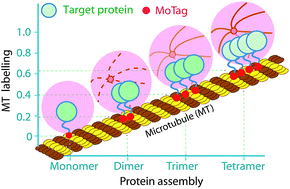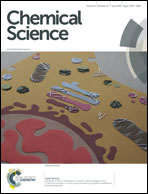Genetically encoded tags for real time dissection of protein assembly in living cells†
Abstract
Simple methods with straightforward readouts that enable real-time interrogation of protein quaternary structure are much needed to facilitate the physicochemical characterization of proteins at the single-cell level. After screening over a series of microtubule (MT) binders, we report herein the development of two genetically encoded tags (designated as “MoTags” for the monomer/oligomer detection tag) that can be conveniently fused to a given protein to probe its oligomeric state in cellulo when combined with routine fluorescence microscopy. In their monomeric form, MoTags are evenly distributed in the cytosol; whereas oligomerization enables MoTags to label MT or track MT tips in an oligomeric state-dependent manner. We demonstrate here the broad utility of engineered MoTags to aid the determination of protein oligomeric states, dissection of protein structure and function, and monitoring of protein–target interactions under physiological conditions in living cells.

- This article is part of the themed collections: 2018 ChemSci Pick of the Week Collection and 2018 Chemical Science HOT Article Collection


 Please wait while we load your content...
Please wait while we load your content...